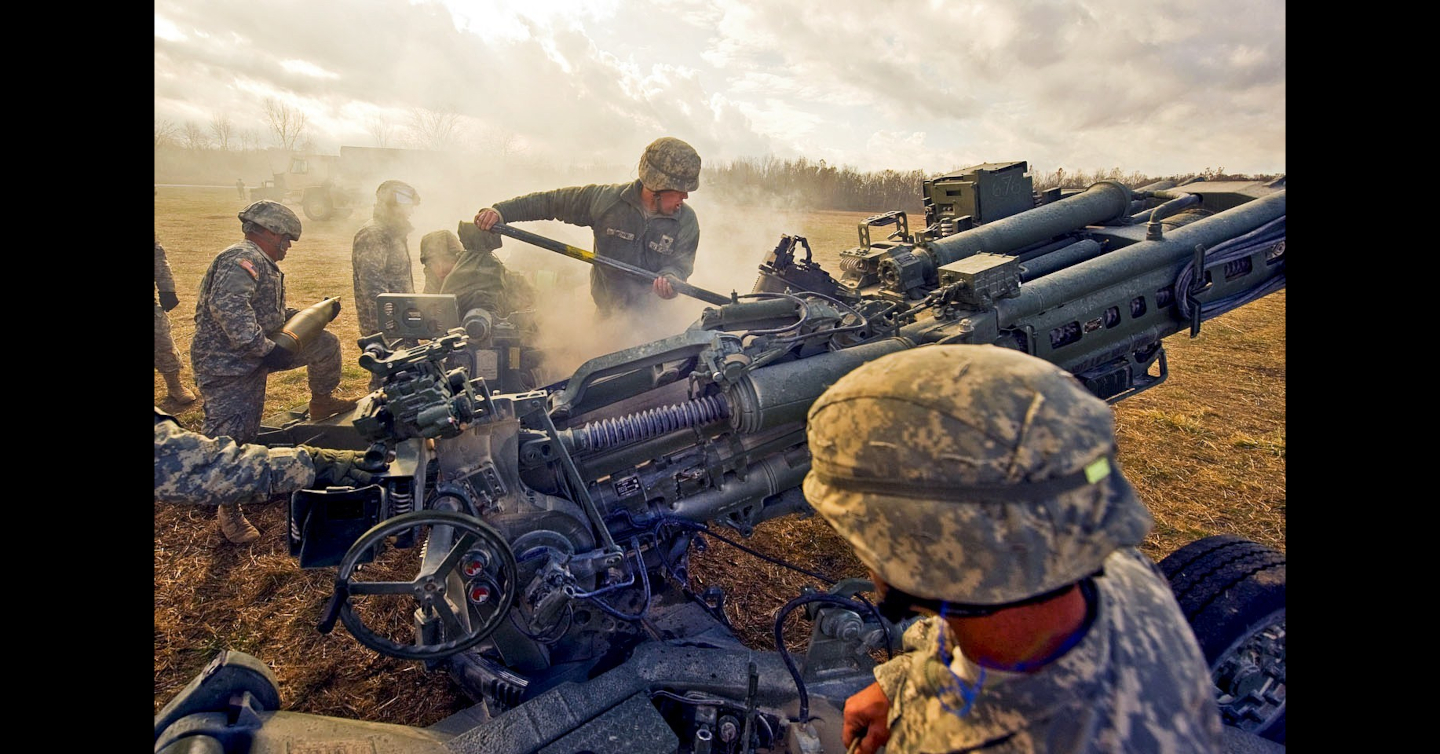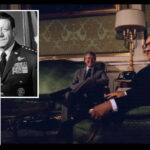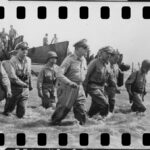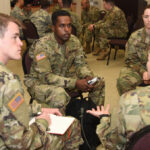
Since the famous flag raising over Mount Suribachi on Iwo Jima, Marines have at least attempted to lay claim to the Pacific as their proprietary theater of operations.
The withdrawal from Afghanistan and budget uncertainty has Army leaders aggressively making the case for the Army’s role in the Pacific, where the Pentagon’s strategic priorities lay. To better position itself in what defense analysts are calling an “all-out interservice fight” for funding, and a “bloodletting,” the Army has played up the value of its traditional contributions like armor, while investing heavily in cutting edge modernizing efforts like long-range, precision fires (for the Pacific). In December, Secretary of the Army Christine Wormuth called the Army “the linchpin service for the joint force” in the Pacific and laid out its key contributions. Army leaders also stressed their service’s contribution to the Indo-Pacific at the Association of the United States Army’s 2021 annual meeting and exposition in October, calling the land domain in “decisive,” and extolling the value of “putting boots on the ground” in the region.” But, at the same time the other services have weighed in. Navalists have argued that the nation doesn’t need a “second Marine Corps,” and that the Pentagon should simply “Give the Navy the Army’s Money.” Air Force leadership has been even more blunt, calling the Army’s long-range precision fires goal “stupid.” However, the Army does have a critical role to play in the landward portion of the Indo-Pacific region, by adding its mass and enabling capabilities to the Marine Corps’ existing efforts. The Marine Corps’ aggressive force design and new concepts Expeditionary Advanced Base Operations and Stand-in Forces should be a blueprint for employment of the U.S. Army in the Indo-Pacific. Ultimately, competition and any potential conflict in the Pacific region will require a fully integrated joint force that leaves no service behind.
Past as Prologue
Since the famous flag raising over Mount Suribachi on Iwo Jima, Marines have at least attempted to lay claim to the Pacific as their proprietary theater of operations. But both history and the current force posture should offer a reality check on that proposition. Today, Army Forces Pacific includes well over 100,000 soldiers, which is nearly 25% larger than the Marines’ regional commitment and equates to more than half of the entire Marine Corps.
The Army has its own Pacific roots having fought a long-running insurgency in the Philippines, and with decades of experience protecting U.S. interests in China before and after the Second World War. During the war, the Army deployed 1.8 million men to the Pacific Theater – nearly three-times the size of the entire Marine Corps at the time. Historian John C. McManus points out in his landmark work on the U.S. Army in the Pacific, Fire and Fortitude, that with the exception of minor operations in Africa and the Caribbean, “every subsequent war involving Army conventional losses [that is, casualties excluding Special Forces] has been fought somewhere on or near the Asian landmass.” (McManus 7) In short, the U.S. Army has a long history of fighting in and around the rim of the Pacific, and it retains an enduring role there.
However, the Marine Corps rightly lays claim to the development of modern amphibious operations during the interwar years. In the 1920s and 1930s, a small and scrappy Marine Corps saw amphibious operations as an opportunity to carve out a new operational niche, ever worried that its traditional roles were under threat from the other services. In their development of amphibious doctrine, the Corps went so far as to suspend classes for a year at its formal school in Quantico so that all of the students could work together on the Tentative Manual for Landing Operations. This manual would eventually become the amphibious doctrine not just for the Marine Corps, but also for the Navy, as Fleet Training Publication 167: Landing Operations Doctrine, which was mostly copied for the Army’s amphibious manual Landing Operations on Hostile Shores. The Marine Corps was also instrumental in training Army units how to conduct amphibious operations in exercises with combined Army-Marine staffs.
Although these efforts helped the Marine Corps make a name for itself as a premier amphibious organization, the U.S. Army carried out far more amphibious operations – including the largest ones. McManus notes that while the Marine Corps made 15 amphibious combat landings during the course of the war, the U.S. 8th Army carried out 35 amphibious landings “over a 5-week period in the Philippines.” (McManus 5) The Army conducted all of the amphibious operations in Europe, including the massive D-Day landings, and many of the amphibious operations in the Pacific were either exclusively Army operations or mixed Army-Marine operations under an Army commander, like the landings on Okinawa. This should not come as much of a surprise because the Army was over six times the size of the Marine Corps. Amphibious operations were developed and perfected by the Marine Corps but they were mostly executed by the Army, because the Army made up the bulk of U.S. forces and the Marine Corps was simply too small to carry out the task alone.
So, What is the Marine Corps Doing Now?
The U.S. Marine Corps has embraced an operating concept called expeditionary advanced base operations (EABO). Small teams of Marines deploy forward to island chains, often persisting within enemy weapon engagement envelopes, providing both maritime domain awareness for the U.S. Navy and area denial through their own fires. Articles have proposed using Marine boats and artillery to counter Peoples’ Liberation Army Navy (PLAN) submarines and contain its surface fleets. With these offensive capabilities persisting forward, U.S. power projection assets, such as its premier surface warships, can minimize their exposure to China’s long-range cueing and weapons. This concept has motivated the Marine Corps to undergo extensive force realignments with divestiture of all their tanks and realignment or paring of many other capabilities that had been expanded over the past 20 years of ground combat.
Today, as the Marine Corps continues to experiment, wargame, and refine its EABO concept, the Army should pay close attention. If history is any indication, the Marine Corps may be developing the very operational concepts that the Army will have to execute and support in the Pacific. In fact, the Marine Corps is explicitly modeling their current doctrinal efforts on its development efforts during the interwar period. Their most recent publication? The Tentative Manual for Advanced Base Operations.
While it is certainly possible that in a regional conflict the Army may be called upon to execute conventional land operations, we think that these five capabilities are the most relevant to a conflict in the Pacific.
How can the Army contribute to EABO?
The Army possesses five key capabilities that the Marine Corps either does not possess at all or in large enough quantity to execute EABO as the sole service. While it is certainly possible that in a regional conflict the Army may be called upon to execute conventional land operations, we think that these five capabilities are the most relevant to a conflict in the Pacific.
First, the Marine Corps has broadcast their intention to acquire anti-ship missiles that it can use against large and medium-sized warships from the landward portion of the littorals with demonstrated recent success. However, the Marine Corps currently maintains only seven active-duty missile and rocket artillery batteries between the active and reserve force. The Commandant has called for tripling the number of these units by replacing traditional cannon artillery with rocket and missile artillery. But even if fully realized, the proposed force design would give the Marine Corps a mere 21 batteries – while the Army has several times that many.
Second, the Army can fulfill the gap in Marine Corps’ air and missile defense. The Marine Corps’ only ground-based defense against enemy aircraft and missiles is the legacy Stinger missile, employed by Low-Altitude Air Defense (LAAD) units. The updated Stinger is still a potent weapon for engaging helicopters and low-flying aircraft. However, it is wholly insufficient for defense against missile strikes and more advanced combat aircraft. To guard against these challenging threats, the Army fields the Patriot Missile system, the Terminal High Altitude Air Defense (THAAD) system, and the Iron Dome system. All but the smallest and most covert advanced base operations will require integrated air defense capability – and likely the integration of platforms and systems that, at present, only reside within the Army.
The third way the Army can contribute to EABO is with their aviation assets. The Army already has experience operating helicopters from naval vessels, spanning from AH-6 “Little Birds” launching from frigates during Operation Prime Chance in the late 1980s, to the recent basing of AH-64E “Apache Guardians” on the Expeditionary Sea Base USS Lewis B. Puller. These gunships can defend against small boat attacks, engage enemy irregular maritime forces at range, and support special operations forces – all of which are relevant missions for a future Pacific conflict. But more importantly, the gunship deployments provide a proof of concept for employing Army aviation from naval vessels and expeditionary advanced bases. Existing Army helicopters of all sorts can and should augment Marine and Navy rotary-wing aviation in a Pacific conflict, adding airborne fires, reconnaissance, and vertical lift. Beyond that quantitative bump, the Army’s aggressive Future Vertical Lift program will also provide a qualitative complement the Marine Corps proven V-22 program, and will allow commanders to move forces between dispersed bases with far greater speed, range, mass, and self-protection.
The fourth critical capability provided by the service’s organic seaborne force. The U.S. Army has dozens of ocean-capable watercraft to move equipment, vehicles, and troops around a theater of operations. The Army’s has already implemented the LCU-2000 and Frank S. Besson-class water craft which are similar in design and capability to the Light Amphibious Warship (LAW) that the Marine Corps hopes to acquire. If Congress funds the LAW program, it will still be years before the Marine Corps receives the dozens of vessels it is requesting. In the meantime, Army watercraft offer reliable intra-theater lift and over-the-shore capability not offered by any other platforms in the current inventory of the Navy or Marine Corps.
Fifth and finally, the Army is particularly qualified to help the Joint Force gain and maintain access in contested areas. Whether executed by the Army or the Marine Corps, EABO requires access to the critical maritime geography of the first island chain. Otherwise, it just doesn’t work. This operational warfighting concept hinges on gaining host nation permission – even as those foreign partners hedge, dither, and cringe at the severe consequences of going to war with China’s military. The persistent work of Army Special Forces, Civil Affairs, Security Force Assistance Battalions, and Psychological Operations soldiers, along with Foreign Area Officers (FAOs), helps gain the requisite access by building local knowledge, relationships, and influence. Much as with quantitative mismatch in rocket artillery batteries, the Army has many times more FAOs that the Marine Corps. What’s more, Army FAOs, like their Navy and now Air Force counterparts, focus undistractedly on the mastery of foreign language, culture, and regional expertise. Marine FAOs, on the other hand, must alternate assignments between FAO work and an unrelated career field like infantry or logistics.
Conclusion
If Army leaders want to make the strongest case possible for the importance of their service in the Pacific, they should follow the Marine Corps’ lead. The Army has unique capabilities in the force and in development like long-range precision fires, advanced air defense, aviation and watercraft that can help operationalize the concepts the Marine Corps has been developing by filling capability gaps in the Marine Corps’ approach to the joint fight. While the Marine Corps force redesign is a step in the right direction, it is not enough to counter the increasing Chinese regional hegemony throughout the vast expanses of the Pacific and demands more than what the Marine Corps, or any one service can provide. Military leaders need to recognize that the Army which yields both unique capacity and unique capabilities, is irreplaceable in the Indo-Pacific and an essential contributor to the joint force in the region.
Lieutenant Commander Collin Fox is a foreign area officer serving as a military advisor with the Department of State
Captain Walker D. Mills is a Marine infantry officer, he is currently serving as an exchange
instructor at the Colombian naval academy. He is also a non-resident fellow at the Brute Krulak Center for Innovation and Future War and a non-resident WSD-Handa Fellow at Pacific Forum.
Lieutenant Commander Dylan “Joose” Phillips-Levine is a naval aviator serving with a tactical air control squadron.
Lieutenant Commander Trevor Phillips-Levine is a naval aviator and is currently serving as a department head in a strike-fighter squadron.
The views expressed in this article are those of the author and do not necessarily reflect those of the U.S. Army War College, the U.S. Army, U.S. Navy, U.S. Marine Corps or the Department of Defense.
Photo Description: Indiana National Guard Soldiers work together to smoothly execute a fire mission using their M777 Howitzers at Camp Atterbury Joint Maneuver Training Center in central Indiana.
Photo Credit: U.S. Army Sgt. John Crosby





While this paper presents a potential path forward for joint warfare, in my opinion, it has many unknowns which all the services solve simultaneously to have a chance of success. It is unclear whether the U.S. Army, the U.S. Marine Corps, the U.S. Navy, the U.S. Air Force, the U.S. Space Command and a U.S. Cyber Command can work effectively to deliver an effective joint warfare capability that has the ability to deliver a strategic victory not a series of tactical victories which will not win wars.
Which many of the concepts mentioned in this paper, the authors fail to address a number of issues. The first issue is whether all the services can provide the targeting information necessary for the U.S. Army long range precision fire to work with sufficient effectiveness or for U.S. Marine Corps to engage within the enemy’s engagement envelopes. We might suspect that the People’s Republic of China would take down our satellites and then would they have to use radar or other means for targeting?
We have reports that the People’s Republic of China has vast experience and a growing capability in Artificial Intelligence. It is not clear that expeditionary advanced base operations (EABO) teams could remain undetected when deploying. The authors think that the U.S. Marine Corps would have to defend the more robust EABO bases but this puts them in a static position as opposed to mobile launch platforms which can fire and move.
The authors fail to address whether the U.S. Navy has the capability to provide the logistical support or SEEBEE construction battalions needed to sustain bases. Does the U.S. Navy have the escort vessels and sea lift to have this even make sense as a concept?